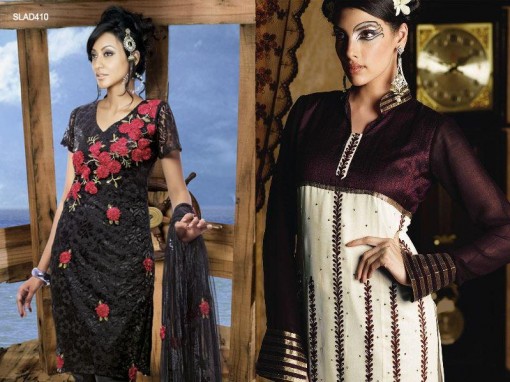Embroidered Salwar Kameez is the traditional wear of Indian women since long time. Popular among Arabs and Mughals of olden days, embroidered ladies salwar suits come in many different styles. Those people prefer embroidered salwar kameez in ordinary cotton fabric with as many as eighty panels with ornate embroidery
and mirror work. Royalty could afford more intricate brocade, tanchoi and heavy satins even with real gold and silver embroidery, studded with precious stones. The embroidered salwar kurta made up of a relaxed fabric, can be worn on festivals or other celebrations. Feminine and graceful, the salwar kurta is bedecked with embroidery and mirror work. The dupatta is also in cheerful colors and has gorgeous embroidery.
and mirror work. Royalty could afford more intricate brocade, tanchoi and heavy satins even with real gold and silver embroidery, studded with precious stones. The embroidered salwar kurta made up of a relaxed fabric, can be worn on festivals or other celebrations. Feminine and graceful, the salwar kurta is bedecked with embroidery and mirror work. The dupatta is also in cheerful colors and has gorgeous embroidery.
shalwarkamez captures the rich saga of womanhood through these embroidered kameez salwar suits, embroidered ladies suits, embroidered salwar kurta and embroidery salwar kameez catalog for online shopping.
The complex embroidered kameez salwar patterns which appear all over the world – from Eastern Europe to Palestine and from Thailand to Morocco – are actually created in a very simple way. Single motifs are uncommon in peasant embroidery; instead the motifs are usually repeated to form straight bands, which are then arranged above one another. Traditional Greek Island designs can have as many as six or seven special bands put together to form an complicated border, which is usually finished with a pattern that creates a broken outer edge. Embroidered salwar kurtas are manufactured in different parts of the world. India is a rich centre of manufacturing and exporting of this garment of ethnic fashion. The salwar kameez is manufactured in most of the indian states.
The word Embroidery comes from the Anglo-Saxon word for “edge”, but the technique itself was being used long before that. The term was first applied to decoratively stitched borders on medieval church vestments. But over time it came to cover all stitched decoration on any fabric fabric. It is an art of hand weaving which is done with the help of needle. It also known as needlework. The earliest known Embroidery examples are from 3000 B.C. They are hand work over the woven threads on clothing. Designs for embroidery came with the traders, first from the Portuguese, then Dutch, and finally the English setting off on long voyages to bring back cargoes of all sorts, especially spices and textiles. Soon from China and eventually India came “musk, rhubarb, pearls, tin, porcelain, and silk and shaped stuff of all kinds.”















